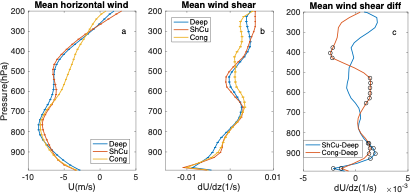Shallow-to-deep convection transition in the ARM GoAmazon observations
Submitter
Klein, Stephen — Lawrence Livermore National Laboratory
Area of Research
Cloud Processes
Journal Reference
Tian Y, Y Zhang, S Klein, and C Schumacher. 2021. "Interpreting the diurnal cycle of clouds and precipitation in the ARM GoAmazon observations: Shallow to deep convection transition." Journal of Geophysical Research: Atmospheres, 126(5), 2020JD033766, 10.1029/2020JD033766.
Science

Figure 1. (a) Composite mean horizontal wind for the three regimes between 0800-1100LST; (b) Composite mean wind shear as calculated by dU/dz; (c) wind shear difference between ShCu and Deep, and between Cong and Deep. The error bars in (a) and (b) represent one standard error, and the black dots in (c) denotes the vertical levels with statistically significant differences at 0.05 significance level. From journal.
The diurnal cycle of convection over land is poorly simulated in most climate models, manifested as a tendency for peak precipitation to occur two to four hours earlier than demonstrated by observations. The inability to correctly represent the diurnal cycle of clouds and precipitation contributes to biases in the simulated top-of-atmosphere (TOA) energy budget and undermines the credibility of climate models. We integrate a suite of ARM observations during the GoAmazon 2014/15 field campaign into a theoretical plume model to systematically diagnose the relative importance of each influencing factor in determining the shallow-to-deep convection transition. This mechanistic understanding of the transition process is crucial to a better representation of the diurnal cycle in climate models.
Impact
Based on the Green Ocean Amazon (GoAmazon) 2014/15 field campaign data, this study builds a comprehensive repository of different convective systems that can serve as valuable case libraries for both observational and modeling studies over the Amazon basin, one of the most important regions in regulating the global hydrological cycle. This study presents clear evidence of how surface and atmospheric conditions affect the shallow-to-deep convection transition and advances our understanding of the diurnal cycle of clouds and precipitation over land. This study reveals the most important factors that should be taken into account in convection parameterizations in large-scale models for a better simulation of the diurnal cycle of clouds and precipitation.
Summary
Observations from the 2014/15 GoAmazon field campaign are used to investigate the most important environmental factors and processes governing the shallow-to-deep convection transition through a careful classification of the locally generated diurnal convective regimes. On shallow cumulus days, a greater sensible heat flux drives deeper boundary-layer growth and a significantly higher cloud base than those on days with deeper convection. Congestus and deep convection days exhibit noticeable differences in the vertical wind shear in the mid-troposphere, suggesting an important role of wind shear in limiting the vertical extent of convection. On deep convection days, the timing of the peak surface precipitation tends to be in phase with the surface heat fluxes when there is pre-existing nocturnal convection or cold pools from external disturbances. ARM observations are then integrated innovatively with a theoretical plume model to systematically diagnose the relative importance of each environmental factor in determining the ultimate cloud-top heights. Initial cloud-base vertical velocity and buoyancy are both important in helping parcels ascend to the level of free convection (LFC). After parcels reach the LFC, entrainment of environmental air and lower free-troposphere humidity become crucial in determining cloud top. Entrainment rate differentiates among convection regimes, which may be tied to the cloud size distribution at cloud base. This study supports the hypothesis of a concerted effort of both nature and nurture for shallow cumulus to transit into deep convection.
Keep up with the Atmospheric Observer
Updates on ARM news, events, and opportunities delivered to your inbox
ARM User Profile
ARM welcomes users from all institutions and nations. A free ARM user account is needed to access ARM data.


















